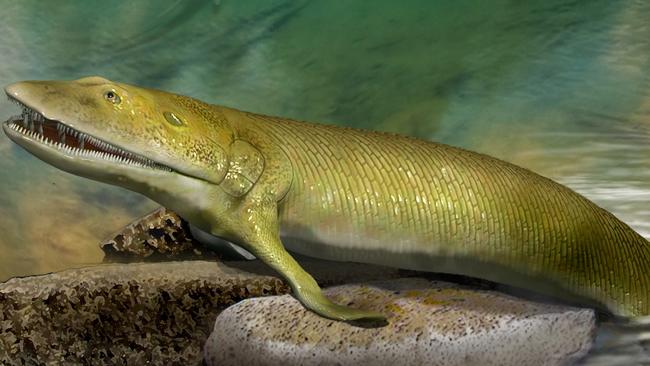Fish with fingers a scientific catch that rewrites history
The discovery of an extraordinary fossil of a fish-like creature has rewritten the story of the origins of the human hand.

Some 380 million years ago, a particularly vicious sea-dwelling predator terrorised the tropical lagoons in which it lived. And this fish was equipped with far more than a mouthful of razor-sharp teeth: it also had the first known fingers.
An extraordinary new fossil of the creature has rewritten the story of the origins of the human hand. The remains reveal how the architecture of our fingers and wrists was present in a pectoral fin of an ancient fish that lived in what is now Quebec.
The researchers behind the discovery have called it “the missing evolutionary link” that explains how four-legged vertebrates clambered from the seas on to land.
“This finding pushes back the origin of digits in vertebrates to the fish level, and tells us that the patterning for the vertebrate hand was first developed deep in evolution, just before fishes left the water,” John Long, a professor in palaeontology at Flinders University in Adelaide, said.
Our dexterity had been key to our success as a species, he added.
“Think of Michelangelo’s Sistine Chapel — a human hand touching the hand of God. This is where it begins.”
The skeleton is about 1.6m long and includes the first complete pectoral fin of a so-called elpistostegalian fish from the Late Devonian period — a time when only plants and invertebrates, among them scorpions and millipedes, had made it on to land. Using computed tomography scans — a form of x-ray — the researchers were able to reveal in its fin an array of bones including a humerus (the equivalent of a human upper arm), a radius and ulna (a forearm), rows of carpus (a wrist) and two phalanges organised in digits (fingers).
Professor Long said the find revealed “extraordinary new information about the evolution of the vertebrate hand. This is the first time that we have unequivocally discovered fingers locked in a fin in any known fish. The articulating digits in the fin are like the finger bones found in the hands of most animals.”
The evolution of fishes into tetrapods — the group of four-legged vertebrates to which humans belong — was one of the most significant events in the history of life. Vertebrates with backbones were then able to leave the water and conquer land. One of the most significant changes was the evolution of hands and feet.
Richard Cloutier, of the University of Quebec in Rimouski, a co-author of a paper published on Thursday in the journal Nature, said over the past decade fossils had improved our understanding of the anatomical transformations associated with breathing, hearing and feeding on land.
The origin of digits would have allowed the fish to support its weight in shallow water or for short trips out on land, he added. “The increased number of small bones in the fin allows more planes of flexibility to spread out its weight through the fin.
“The other features the study revealed concern the structure of the upper arm bone or humerus, which also shows features present that are shared with early amphibians. Elpistostege is not necessarily our ancestor, but it is the closest we can get to a true ‘transitional fossil’ — an intermediate between fishes and tetrapods.”
The Times



To join the conversation, please log in. Don't have an account? Register
Join the conversation, you are commenting as Logout